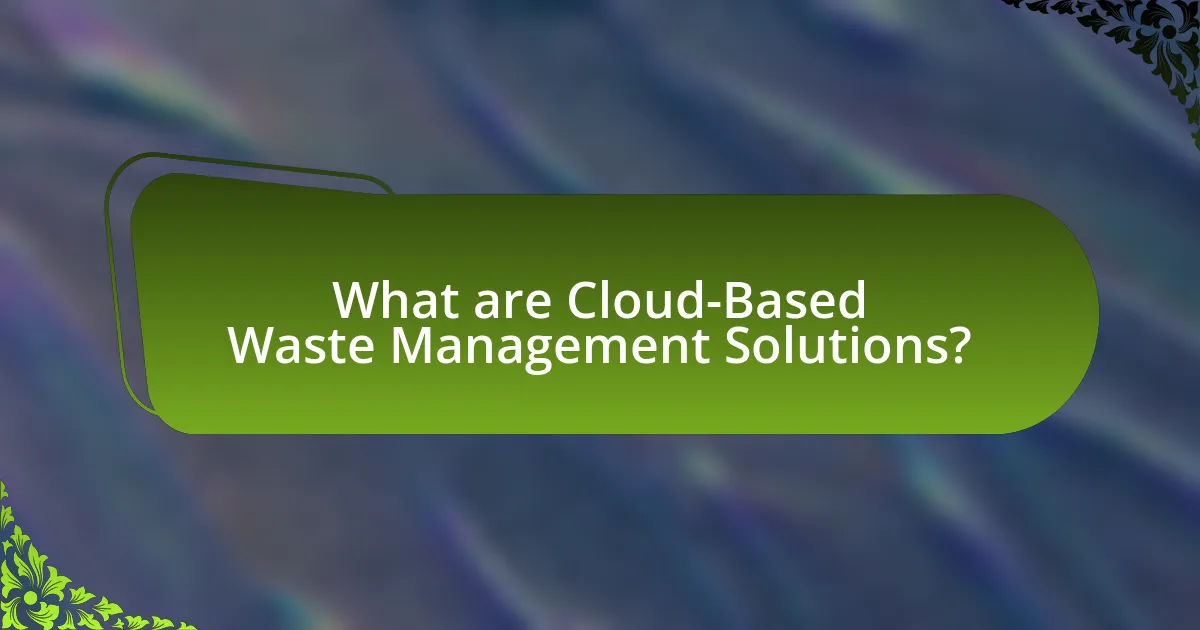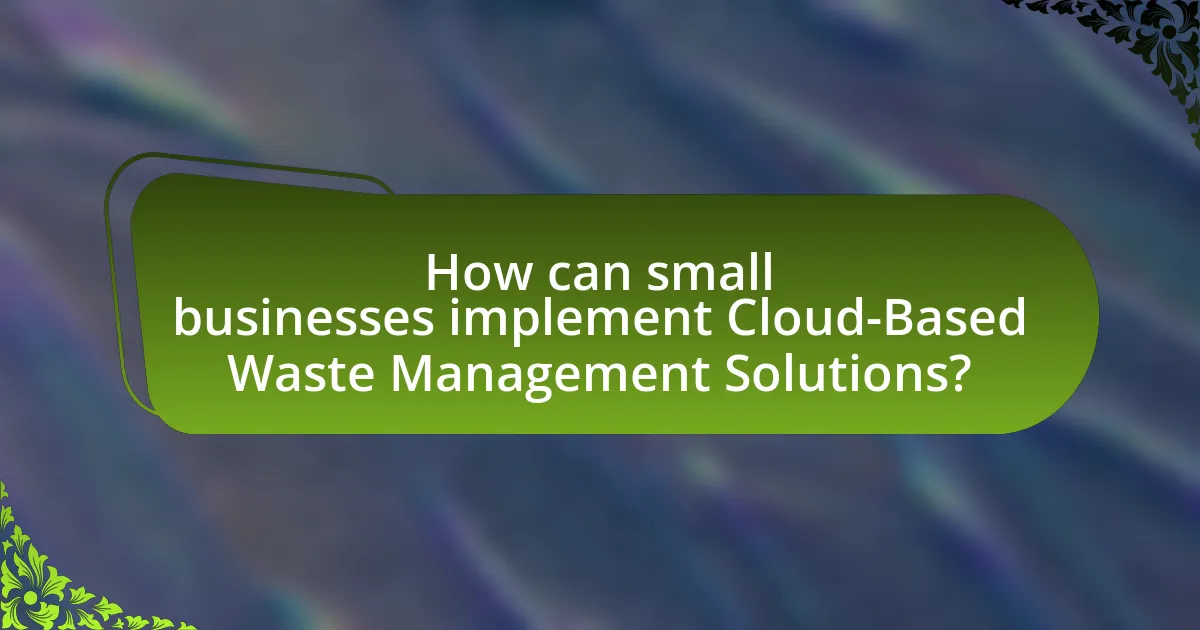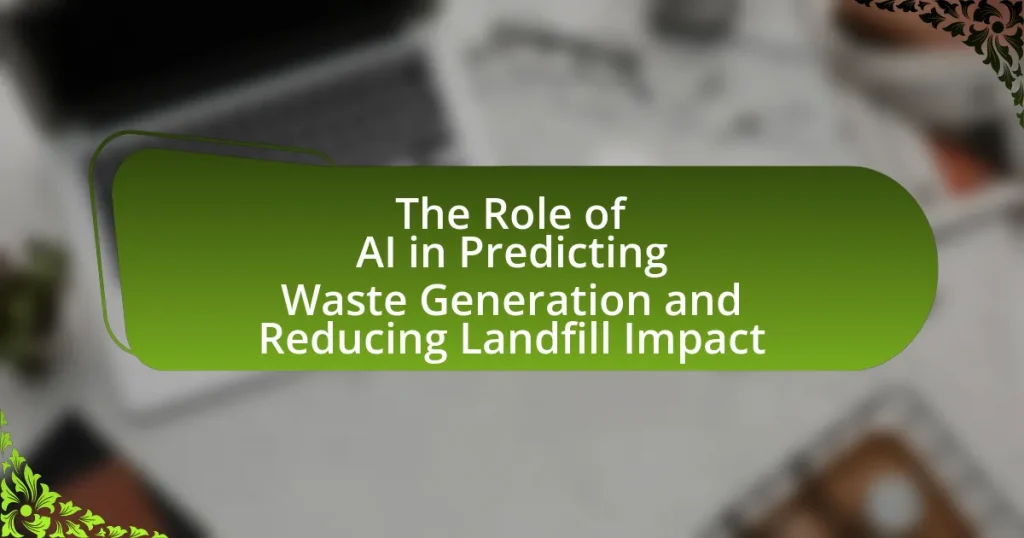Cloud-based waste management solutions are digital platforms that leverage cloud computing technology to enhance waste management processes for small businesses. These solutions enable real-time monitoring of waste generation, efficient tracking of disposal methods, and data analysis, leading to improved operational efficiency and cost savings. Key features include automated reporting, route optimization, and real-time data analytics, which collectively contribute to reduced operational expenses and increased recycling rates. The article explores how small businesses can implement these solutions, the benefits they offer, and best practices for maximizing their effectiveness while addressing potential challenges during the transition.

What are Cloud-Based Waste Management Solutions?
Cloud-based waste management solutions are digital platforms that utilize cloud computing technology to streamline and optimize waste management processes. These solutions enable businesses to monitor waste generation, track disposal methods, and analyze data in real-time, enhancing operational efficiency. According to a report by MarketsandMarkets, the global waste management market is projected to reach $530 billion by 2025, driven by the adoption of innovative technologies like cloud-based systems. This indicates a growing trend towards digital transformation in waste management, particularly beneficial for small businesses seeking cost-effective and efficient waste handling practices.
How do Cloud-Based Waste Management Solutions operate?
Cloud-based waste management solutions operate by utilizing internet-based platforms to streamline waste collection, tracking, and reporting processes. These systems enable real-time data access and analytics, allowing businesses to monitor waste generation and disposal efficiently. For instance, sensors can be integrated into waste bins to provide data on fill levels, which helps optimize collection routes and schedules, reducing operational costs. Additionally, cloud technology facilitates the integration of various data sources, enabling businesses to analyze trends and make informed decisions regarding waste reduction and recycling efforts. This operational efficiency is supported by the ability to access and manage data from any location, enhancing responsiveness and adaptability in waste management practices.
What technologies are involved in Cloud-Based Waste Management Solutions?
Cloud-Based Waste Management Solutions involve several key technologies, including Internet of Things (IoT) sensors, cloud computing platforms, data analytics, and mobile applications. IoT sensors are deployed on waste bins to monitor fill levels and optimize collection routes, while cloud computing platforms store and process data in real-time, enabling efficient management. Data analytics tools analyze waste generation patterns, helping businesses make informed decisions. Mobile applications facilitate communication between waste management providers and businesses, enhancing service delivery. These technologies collectively improve operational efficiency and reduce costs for small businesses in waste management.
How do these technologies enhance waste management processes?
Cloud-based waste management technologies enhance waste management processes by improving data accessibility and operational efficiency. These technologies enable real-time tracking of waste generation and disposal, allowing businesses to optimize collection routes and schedules, which can lead to a reduction in operational costs by up to 30%. Additionally, cloud solutions facilitate better communication between stakeholders, ensuring timely updates and compliance with regulations. For instance, a study by the Environmental Protection Agency found that businesses utilizing cloud-based systems reported a 25% increase in recycling rates due to improved monitoring and reporting capabilities.
What are the key features of Cloud-Based Waste Management Solutions?
Cloud-Based Waste Management Solutions offer several key features that enhance efficiency and effectiveness in waste management. These features include real-time data tracking, which allows businesses to monitor waste generation and disposal in real-time, leading to informed decision-making. Additionally, these solutions provide automated reporting capabilities, enabling users to generate compliance reports effortlessly, thus ensuring adherence to regulations.
Another significant feature is the integration of route optimization algorithms, which help in planning efficient waste collection routes, reducing fuel consumption and operational costs. Furthermore, cloud-based platforms often include user-friendly dashboards that present data analytics visually, making it easier for small businesses to interpret and act on waste management metrics.
These features collectively contribute to improved operational efficiency, cost savings, and enhanced sustainability practices for small businesses in waste management.
How do real-time data analytics contribute to waste management?
Real-time data analytics significantly enhance waste management by providing immediate insights into waste generation patterns and operational efficiencies. These analytics enable waste management companies to monitor waste levels in containers, optimize collection routes, and predict future waste generation based on historical data. For instance, a study by the Environmental Protection Agency found that implementing real-time analytics can reduce collection costs by up to 30% and improve recycling rates by 20%. This data-driven approach allows for more effective resource allocation and reduces the environmental impact of waste disposal.
What role does automation play in these solutions?
Automation plays a crucial role in cloud-based waste management solutions for small businesses by streamlining processes and enhancing efficiency. It enables real-time tracking of waste generation and disposal, allowing businesses to optimize their waste management strategies. For instance, automated scheduling of waste pickups reduces operational costs and minimizes environmental impact by ensuring timely collection. Additionally, automation facilitates data analysis, providing insights that help businesses make informed decisions regarding waste reduction and recycling efforts. This efficiency is supported by studies showing that automated systems can reduce waste management costs by up to 30%, demonstrating the tangible benefits of integrating automation into waste management practices.

What benefits do Cloud-Based Waste Management Solutions offer small businesses?
Cloud-based waste management solutions offer small businesses enhanced efficiency, cost savings, and improved data management. These solutions streamline waste tracking and reporting processes, allowing businesses to monitor waste generation and disposal in real-time. According to a study by the Environmental Protection Agency, businesses that implement cloud-based systems can reduce operational costs by up to 30% through optimized waste management practices. Additionally, cloud solutions provide access to analytics and reporting tools that help small businesses make informed decisions, ultimately leading to better sustainability outcomes and compliance with regulations.
How can small businesses reduce costs with Cloud-Based Waste Management Solutions?
Small businesses can reduce costs with Cloud-Based Waste Management Solutions by optimizing waste collection schedules and improving resource allocation. These solutions utilize data analytics to assess waste generation patterns, allowing businesses to adjust their waste disposal frequency and methods, which can lead to significant savings on collection fees. For instance, a study by the Environmental Protection Agency found that businesses implementing data-driven waste management strategies can reduce waste disposal costs by up to 30%. Additionally, cloud-based systems enable real-time monitoring of waste levels, helping businesses avoid overpaying for unnecessary pickups and ensuring compliance with local regulations, further minimizing potential fines.
What specific cost-saving features are available?
Cloud-based waste management solutions offer several specific cost-saving features, including real-time tracking of waste generation, automated reporting, and optimized routing for collection vehicles. Real-time tracking allows businesses to monitor waste levels and adjust collection schedules, reducing unnecessary pickups and associated costs. Automated reporting streamlines compliance and reduces administrative labor, saving time and money. Optimized routing minimizes fuel consumption and labor costs by ensuring collection vehicles take the most efficient paths. These features collectively contribute to significant operational savings for small businesses.
How do these solutions minimize operational expenses?
Cloud-based waste management solutions minimize operational expenses by automating processes and optimizing resource allocation. These solutions reduce the need for manual labor and paperwork, leading to lower staffing costs and decreased administrative overhead. For instance, a study by the Environmental Protection Agency found that businesses using automated waste tracking systems can reduce waste disposal costs by up to 30% through improved efficiency and better data analysis. Additionally, real-time monitoring allows businesses to adjust their waste management strategies dynamically, further cutting costs associated with over-collection or under-utilization of resources.
In what ways do these solutions improve efficiency for small businesses?
Cloud-based waste management solutions improve efficiency for small businesses by automating waste tracking and reporting processes. These solutions enable real-time data access, allowing businesses to monitor waste generation and disposal patterns effectively. For instance, a study by the Environmental Protection Agency indicates that businesses utilizing cloud-based systems can reduce waste management costs by up to 30% through optimized collection schedules and reduced landfill fees. Additionally, these solutions facilitate better compliance with regulations by providing timely updates and documentation, which minimizes the risk of fines and enhances operational transparency.
How does streamlined communication enhance waste management?
Streamlined communication enhances waste management by facilitating real-time information sharing among stakeholders, which leads to improved decision-making and operational efficiency. Effective communication channels allow waste management teams to quickly report issues, coordinate collection schedules, and respond to changes in waste generation patterns. For instance, a study by the Environmental Protection Agency indicates that organizations utilizing integrated communication platforms can reduce response times to waste-related incidents by up to 30%, thereby minimizing disruptions and optimizing resource allocation. This efficiency not only lowers operational costs but also contributes to more sustainable waste management practices.
What impact does improved scheduling have on waste collection?
Improved scheduling significantly enhances waste collection efficiency by optimizing routes and reducing operational costs. Efficient scheduling allows waste management companies to allocate resources more effectively, leading to timely pickups and minimized delays. According to a study by the Environmental Protection Agency, optimized waste collection routes can reduce fuel consumption by up to 30%, which not only lowers costs but also decreases greenhouse gas emissions. This efficiency translates into better service for customers and a more sustainable waste management process overall.

How can small businesses implement Cloud-Based Waste Management Solutions?
Small businesses can implement cloud-based waste management solutions by selecting a suitable software platform that integrates waste tracking, reporting, and analytics. These platforms often provide features such as real-time data access, automated reporting, and customizable dashboards, which enhance operational efficiency. For instance, according to a study by the Environmental Protection Agency, businesses that utilize cloud-based solutions can reduce waste management costs by up to 30% through improved data visibility and decision-making. Additionally, small businesses should train their staff on the new system to ensure effective utilization and maximize the benefits of the technology.
What steps should small businesses take to transition to cloud-based solutions?
Small businesses should follow a structured approach to transition to cloud-based solutions by assessing their current infrastructure, selecting appropriate cloud services, and training employees. First, businesses must evaluate their existing IT systems to identify which applications and data can be migrated to the cloud. Next, they should choose cloud service providers that align with their specific needs, considering factors such as scalability, security, and cost-effectiveness. Finally, providing comprehensive training for employees ensures they are equipped to utilize the new cloud-based tools effectively. This methodical transition can enhance operational efficiency and reduce costs, as evidenced by a report from Gartner indicating that cloud adoption can lead to a 20-30% reduction in IT expenses for small businesses.
What factors should be considered during the implementation process?
During the implementation process of cloud-based waste management solutions for small businesses, key factors to consider include system compatibility, user training, data security, and cost-effectiveness. System compatibility ensures that the new solution integrates seamlessly with existing technologies, which is crucial for operational efficiency. User training is essential to equip staff with the necessary skills to utilize the system effectively, thereby maximizing its benefits. Data security must be prioritized to protect sensitive information from breaches, as cloud solutions can be vulnerable to cyber threats. Lastly, cost-effectiveness should be evaluated to ensure that the investment aligns with the business’s budget and provides a favorable return on investment. These factors collectively contribute to a successful implementation and optimal utilization of cloud-based waste management solutions.
How can businesses ensure a smooth transition to these solutions?
Businesses can ensure a smooth transition to cloud-based waste management solutions by implementing a structured change management plan. This plan should include thorough training for employees on the new system, which has been shown to increase user adoption rates by up to 70% according to a study by Prosci. Additionally, businesses should conduct a pilot program to identify potential issues before full implementation, allowing for adjustments based on real-world feedback. Engaging stakeholders throughout the process fosters buy-in and reduces resistance, as highlighted in research by McKinsey, which indicates that effective communication can enhance project success rates by 30%. By following these steps, businesses can facilitate a seamless transition to cloud-based waste management solutions.
What challenges might small businesses face when adopting these solutions?
Small businesses may face several challenges when adopting cloud-based waste management solutions, including cost, technical expertise, and data security concerns. The initial investment for cloud solutions can be significant, which may strain limited budgets. Additionally, small businesses often lack the technical expertise required to implement and maintain these systems effectively, leading to potential operational disruptions. Furthermore, data security is a critical issue, as small businesses must ensure that sensitive information is protected against breaches, which can be particularly challenging without dedicated IT resources. These challenges highlight the complexities small businesses encounter in transitioning to cloud-based waste management solutions.
How can small businesses overcome resistance to change?
Small businesses can overcome resistance to change by fostering a culture of open communication and involving employees in the change process. Engaging staff in discussions about the benefits of new systems, such as cloud-based waste management solutions, can help alleviate fears and build support. Research indicates that organizations that prioritize employee involvement during transitions experience a 70% higher success rate in implementing change initiatives. By providing training and demonstrating the tangible benefits of the new system, small businesses can further reduce resistance and encourage a smoother transition.
What are common technical issues and how can they be resolved?
Common technical issues in cloud-based waste management solutions include data security vulnerabilities, system integration challenges, and connectivity problems. Data security vulnerabilities can be resolved by implementing robust encryption protocols and regular security audits to protect sensitive information. System integration challenges can be addressed by utilizing standardized APIs and ensuring compatibility with existing software systems, which facilitates seamless data exchange. Connectivity problems can be mitigated by ensuring reliable internet access and employing backup connectivity solutions, such as mobile hotspots, to maintain service continuity. These resolutions are supported by industry best practices that emphasize security, interoperability, and reliability in cloud computing environments.
What best practices should small businesses follow when using Cloud-Based Waste Management Solutions?
Small businesses should prioritize data security, user training, and integration with existing systems when using Cloud-Based Waste Management Solutions. Ensuring data security involves implementing strong access controls and encryption to protect sensitive information, as breaches can lead to significant financial and reputational damage. User training is essential to maximize the effectiveness of the solution; employees must understand how to utilize the software efficiently to optimize waste management processes. Additionally, integrating the cloud solution with existing business systems, such as inventory management or accounting software, enhances operational efficiency and data accuracy, leading to better decision-making. These practices are supported by industry reports indicating that businesses that prioritize security and training experience fewer operational disruptions and improved compliance with waste regulations.
How can businesses maximize the benefits of these solutions?
Businesses can maximize the benefits of cloud-based waste management solutions by integrating these systems into their operational workflows and ensuring staff are trained to utilize them effectively. By adopting a comprehensive approach that includes regular data analysis and performance monitoring, businesses can identify inefficiencies and optimize waste reduction strategies. Research indicates that companies using cloud-based solutions can reduce waste management costs by up to 30% through improved tracking and reporting capabilities. Additionally, leveraging real-time data allows businesses to make informed decisions that enhance sustainability efforts and compliance with regulations.
What ongoing maintenance is required for optimal performance?
Ongoing maintenance for optimal performance of cloud-based waste management solutions includes regular software updates, data backups, and system monitoring. Regular software updates ensure that the system operates with the latest features and security patches, which is crucial for protecting sensitive data and maintaining efficiency. Data backups are essential to prevent loss of information and ensure business continuity in case of system failures. System monitoring involves tracking performance metrics and user activity to identify potential issues before they escalate, thereby maintaining operational efficiency. These maintenance practices are supported by industry standards that emphasize the importance of proactive management in cloud environments to enhance reliability and performance.



